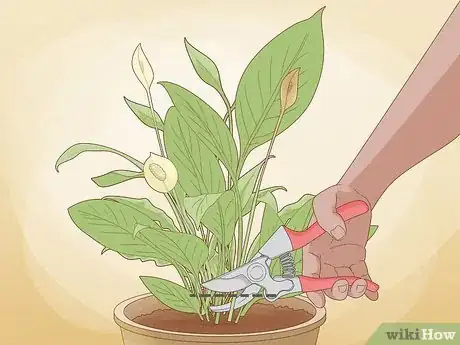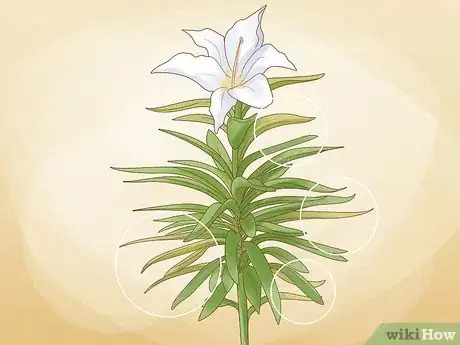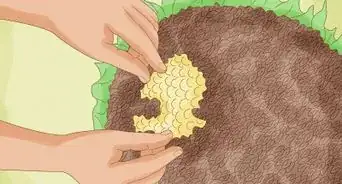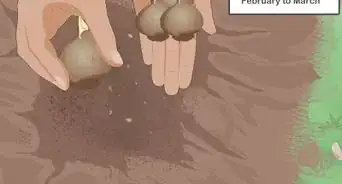This article was co-authored by Maggie Moran. Maggie Moran is a Professional Gardener in Pennsylvania.
wikiHow marks an article as reader-approved once it receives enough positive feedback. In this case, 96% of readers who voted found the article helpful, earning it our reader-approved status.
This article has been viewed 238,706 times.
Lilies make a lovely addition to any garden, and unlike a lot of plants, they don’t have to be pruned during their blooming period. Instead, wait until after they’re done blooming – usually after the first frost – to prune them. When you prune dying blooms, make sure you prune the entire stem, down to the base of the flower. If you notice dying foliage, look to see how extensive the damage is. If only the tips of leaves are browning, clip just the tips.
Steps
Deadheading Dying Blooms
-
1Deadhead dying blooms throughout the blooming season. If any of your lilies begin to wilt or look brown, you can deadhead them, even if the plant is still blooming. Depending on the variety of lily you have, removing dead flowers may encourage new growth. Even if it doesn’t, it will help make your lily plant and your garden look neater.Expert AnswerQ
A wikiHow reader asked: "Do I need to deadhead my lilies?"
Maggie Moran is a Professional Gardener in Pennsylvania.Home & Garden Specialist
 EXPERT ADVICEAnswer from Maggie Moran:
EXPERT ADVICEAnswer from Maggie Moran:Maggie Moran, a professional horticulturist, responds: "It is a good idea to deadhead lilies not only for the appearance of your garden but also to help the lily focus its growing energies to new blooms."
-
2Use small, lightweight shears to prune your lilies. Bypass pruners and grass shears both look like large pairs of scissors, but they're lightweight. They tend to make a gentler cut than other types of shears, which is ideal for delicate lily blooms. You can use the same shears to prune.[1]Advertisement
-
3Follow the stalk of the flower into the base of the lily plant. Lilies flower at the end of a long stalk attached to the center of the lily plant. To “deadhead” lilies, you need to follow the stalk all the way down to the base. You may not be able to see into the center of the plant. If you can’t, use your hand to follow the stalk down.
- If you’re feeling your way to the base, make sure you wear gloves.
-
4Cut the stalk at the base of the plant. Instead of pinching the flower off just behind the bud, you’ll want to remove it at the end of the stalk. Use pruning shears to clip the stalk right at the base of the plant. Get as close as you can to the base – you shouldn’t leave a stub.
-
5Disinfect your shears in between cuts. If you’re shearing dead or diseased blooms or foliage, it’s important to disinfect the shears in between cuts. Otherwise, you risk spreading disease to healthy parts of the plant. To disinfect, dip the blades of the shears into a solution of 1 part vinegar to 2 parts water.[2]
Removing Browning Foliage
-
1Leave yellowing or browning stalks until the fall. If you notice that some of the foliage is turning yellow, but not brown, leave it alone. The yellow stalks won’t affect the overall health of your plant, and cutting them down early actually decreases the amount of energy the plant can produce.
-
2Prune back yellow stalks after the first frost. Once the first frost has occurred, your lily plant no longer needs the energy produced by the foliage stalks. Use your shears to cut the yellow foliage stalks down to the ground.
-
3Remove entire stems of mostly brown leaves. If quite a few of the leaves on one stem are brown, you should remove the entire stem. Follow the stem to the base of the lily plant, then use pruning shears to cut off the entire stem. Be sure you don’t leave a stub at the base of the plant.[3]
-
4Clip the tips of browning leaves. If you notice that just the tips of the leaves on your lily plant are browning, you don’t need to remove the whole stem. Instead, make an angled clip just below the browning tip. The plant should grow a new healthy green tip.[4]
Expert Q&A
-
QuestionWhen can you cut back daylilies?
 Maggie MoranMaggie Moran is a Professional Gardener in Pennsylvania.
Maggie MoranMaggie Moran is a Professional Gardener in Pennsylvania.
Home & Garden Specialist You should cut back daylilies after the growing season has concluded. Wait until there are no more blooms on your plant to begin pruning.
You should cut back daylilies after the growing season has concluded. Wait until there are no more blooms on your plant to begin pruning. -
QuestionCan Asiatic lilies be cut back?
 Maggie MoranMaggie Moran is a Professional Gardener in Pennsylvania.
Maggie MoranMaggie Moran is a Professional Gardener in Pennsylvania.
Home & Garden Specialist Yes, they should be cut back after the first frost of fall has passed but before the ground is frozen.
Yes, they should be cut back after the first frost of fall has passed but before the ground is frozen. -
QuestionDo you have to water lilies after they've finished flowering?
 wikiHow Staff EditorThis answer was written by one of our trained team of researchers who validated it for accuracy and comprehensiveness.
wikiHow Staff EditorThis answer was written by one of our trained team of researchers who validated it for accuracy and comprehensiveness.
Staff Answer wikiHow Staff EditorStaff AnswerYes, it would be best to water your lilies around once a week to keep your plant healthy and encourage beautiful blooms during the spring-summer months.
wikiHow Staff EditorStaff AnswerYes, it would be best to water your lilies around once a week to keep your plant healthy and encourage beautiful blooms during the spring-summer months.
Things You'll Need
- Lightweight pruning shears
- Vinegar
- Water
- Gardening gloves
References
About This Article
To prune lilies, deadhead any dying blooms throughout the growing season, which will encourage new growth and improve the appearance of your garden. To deadhead a bloom, follow the stalk of the flower all the way down to the base of the plant. Then, use small, lightweight shears to cut the stalk off right at the base. If you're cutting off multiple stalks, disinfect the shears in 1 part vinegar and 2 parts water in between cuts. For more advice from our Horticulture co-author, like how to prune off browning foliage, scroll down!





































































